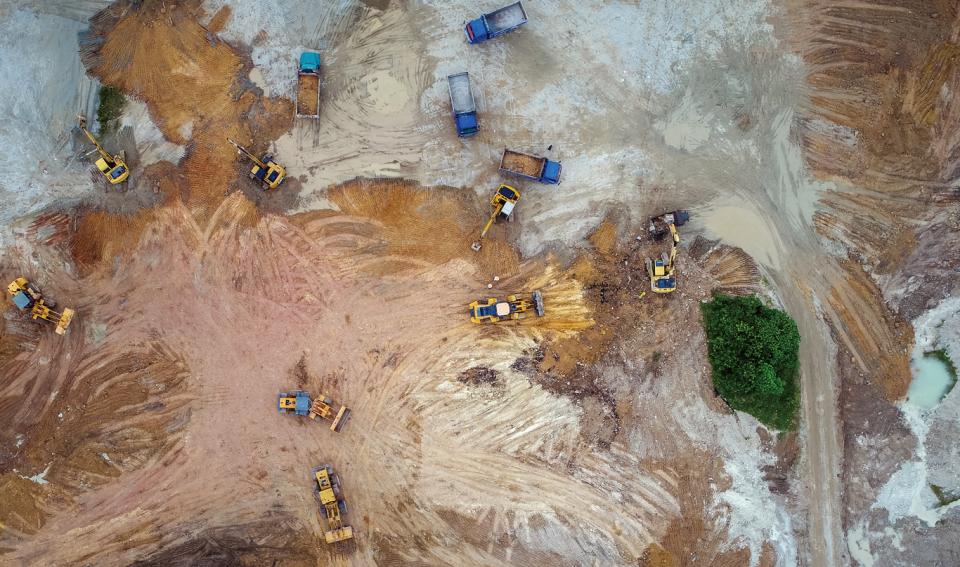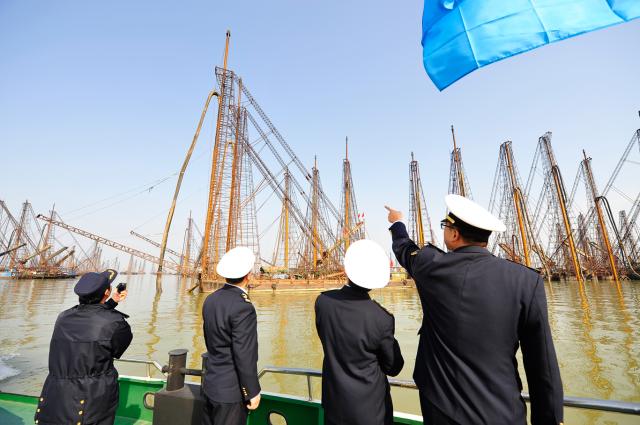“We will never take an order from that construction company again. We used to bribe them before we got a contract, but now they offer a contract voluntarily because of the lack of sand and gravel,” Ma Jianxiong, a production manager at a concrete mixing plant in Hefei, East China’s Anhui Province, told his employee after he hung up the phone.
There is also a sand shortfall in the city of Qingdao in Shandong Province. Previously, a sand dealer supplying large construction sites only had to search for sources within a 100 kilometer radius, but now the search area has doubled, at least. It means that a lot of the sand is obtained through illegal means.
To address the nationwide supply shortage, Hu Youyi, director of the China Aggregates Association, told NewsChina that he recently met with policymakers in Beijing. “China is proposing measures to address the weak links [in supply], but many projects are already suspended because of the scarcity of sand. The central government is paying attention to the issue,” he said. “Each square meter of an apartment needs at least 800 kilograms of sand.” Sand and gravel, also known as aggregates, are crucial ingredients in the construction industry to make brick, concrete and asphalt. It makes them one of the most-consumed natural resources on the planet. The accelerating demands during China’s construction boom over the past decade have severely strained supplies.
The sand used in construction is mostly extracted from the bottom of rivers, lakes and oceans. Desert sand is unsuitable for construction because the grains are too round from wind erosion and do not stick together.
Every evening in Hefei’s Yaohai District, heavily loaded trucks carrying sand and construction materials rumble along the streets. Most of the sand comes from Liu’an, a city to the west of Hefei, more than 200 kilometers away. Ma told our reporter that truck drivers regularly scan for information in groups on social media app WeChat, which regularly post the latest sand prices. If there is profit to be made, truck drivers will transport sand from Liu’an to Hefei.
A truck driver told our reporter on condition of anonymity that now it is not easy to obtain sand in Liu’an after limits were put on the quantity that can be extracted. As a result, the price of sand is going up. Ma said sand cost 40 yuan (US$5.7) per ton before 2018, but now it has soared to 130 yuan (US$18.6). The biggest problem nowadays, he said, is the lack of resources despite the price hike.
The Yangtze River Delta is China’s main sand-mining zone. In 2006, 2011 and 2016, the Ministry of Water Resources released three sand-mining plans in the area, specifying the amount, scope and duration of sand exploitation.
Zhang Yuanfeng, an employee at the sand-mining management bureau of Jin’an District in Liu’an, told NewsChina that it is common for production to far exceed the quota. “In 2018, we had a sand exploitation quota of three million tons but nearly 10 million tons were sold in our district,” he said. “To make matters worse, the sales volume is very likely underestimated.”
In the late 1990s, each household could exploit sand freely from the Pihe River in the district. After 2009, when the sand-mining management bureau was established, only enterprises with complete facilities including sand dredgers, front loaders and shipping paths could bid for licenses to extract sand.
Zhang Yuanfeng said a mining permit was issued for three to five years, and once an enterprise gets one, it usually exploits sand beyond the width and depth of the area specified in the license. This over-exploitation kept the price of sand low for many years, but it has also had a devastating impact on the environment.
According to a World Wildlife Fund report, sand extraction in the first decade of the 21st century in Poyang Lake in Jiangxi Province, the world’s largest sand extraction site, exceeded the total amount of sand accumulation over the past 55 years. Zhou Jianjun, a professor at the Department of Hydraulic and Engineering at Tsinghua University, told our reporter that Poyang Lake is the water zone that is most impacted by sand exploitation.
From 2015 to 2016, Chen Yushun, a researcher at the Institute of Hydrobiology under the Chinese Academy of Sciences (CSC), conducted research on the effects of sand mining in Dongting Lake, Hunan Province, as well as Poyang Lake, both part of the Yangtze River Delta. He found it was difficult to collect first-hand data about sand mining. One time, there were 450 and 360 dredgers illegally working on the two lakes at the same time.
“We could only look at the number of working sand dredgers, make a comparison between satellite remote sensing photos or get information from local miners,” he told NewsChina. “Hydrological departments have limited information about sand mining. For example, if an enterprise’s quota is 500,000 tons, it is anybody’s guess as to the exact amount of extraction.” Professor Zhou Jianjun said sand extraction has caused a dramatic decline in the water levels of Poyang Lake, the country’s largest freshwater lake. It has also wreaked havoc on the navigation, rural irrigation, domestic water and water quality of the region.
Poyang Lake was a habitat for the Yangtze finless porpoise, a highly endangered species in China. In 2012, the CSC’s Institute of Hydrobiology found Poyang Lake was home to 450 porpoises, but a year later the number dropped to zero.
According to the national gazette on river sedimentation in 2018, the three largest water monitoring stations in the Yangtze River Delta recorded a decrease of 91 percent, 76 percent and 77 percent of sediment delivery in comparison to half a century ago.
“The problem is made worse in many rivers because we do not have reliable estimates of the rate of natural sand replenishment, and we don’t know how this matches extraction rates, with the matter often only being apparent when shortages produce detrimental effects,” Jim Leonard, a geology professor at the University of Illinois at Urbana-Champaign, told NewsChina.
In early 2016, Chinese President Xi Jinping spoke at a symposium on promoting the development of the Yangtze Economic Belt when he said that the Yangtze River is very sick. “We must make restoring the ecological environment of the Yangtze River a top priority,” he said. Since then, illegal sand mining has become one of the six areas targeted to protect the environment. On June 19, 2018, the Ministry of Water Resources launched a six-month campaign to crack down on illegal sand mining.
Starting in June 2017, the operating permits of six sand-mining enterprises in Matou County in Liu’an expired and they were unable to extend the contract because the Anhui provincial water resources department had halted the old auction and bidding methods for permits. State-owned sand-mining enterprises were established to hire private sand dredgers. In 2017, many cities and counties ceased private sand-mining in Dongting Lake.
In October 2017, all 13 sand-mining spots in Jin’an District in Liu’an were owned by the government and each sand mining spot was given a quota of 60,000 tons per month, with each ton only worth 15 yuan (US$2).
Zhang Yuanfeng told our reporter that Jin’an District has adopted digital management and all trucks carrying sand are weighed when they leave the sand-mining spots. Once the 60,000-ton quota is used up, trucks are prohibited from entering the sand-mining sites. He said that without the new system, sand resources in the Pihe River would be depleted by 2022.
NewsChina visited a sand-mining site at the Pihe River and found there were no operating sand-mining dredgers nor trucks on the bank. Several workers were playing cards in a shelter. This sand-mining spot and two others in the district had not been granted a permit as they failed to obtain environmental approval.
Han Ming, director of the water supervision department at Huoshan County in Anhui Province, told NewsChina that the county was home to a number of small sand-mining enterprises and many of them did not have a dredger and only large diesel pumps were used. After a rectification campaign in 2014, there were only 12 legal sand-mining enterprises left which could only operate on three sections of the river. In March 2017, virtually all 90 sand-mining enterprises in Huoshan County were closed. In June 2018, the Ministry of Ecology and Environment conducted a survey in the area and concluded that sand-mining activities had affected the quality of drinking water in Liu’an. Two months later, all sand-mining operations in the Pihe River were shut down.
By October 2018, all 20 major sand-mining enterprises in Henan Province were State-owned. In December 2018, more than 1,700 sand-mining dredgers were checked for environmental concerns in Hubei Province and some illegal ones were instantly dismantled. The nationwide campaign to crack down on illegal mining activities has left many provinces to suffer from sand shortfalls and the price of sand has been going through the roof. In 2017, sand from the Pihe River was priced at 30 yuan (US$4.3) a ton and shot up to 150 yuan (US$21) in the first half of 2019.
A research paper published in the journal of Management on Rivers and Lakes by Fan Xiaowei, an employee at the Anhui Water Resources Bureau in 2018, said that China’s sand and gravel management has been treated mainly as a water activity and its market demands have largely been overlooked. He pointed out that in order to cut the profit chain of illegal sand exploitation, it is urgent to take action from the supply side.
“When we consider the available sand, we have to consider what sand is available in a manner that is sustainable and minimizes the environmental impact, while also realizing that sand is a vital ingredient for modern society and the livelihoods of many,” said Jim Leonard.
Man-made sand and gravel have become popular alternatives in facing the sand shortfall. Professional machines are used to break rocks and produce aggregates in different construction grades. In China’s western mountainous province of Guizhou, machine-made sand is the most common product on construction sites. Amid the rising price of sand, Guizhou is the cheapest source of sand for nearby provinces. In September 2019, the Ministry of Industry and Information Technology sought advice from the local government of Guizhou to cooperate on sand production.
According to statistics from the China Aggregates Association, machine-made sand accounts for 80 percent of China’s total consumption. “Generally speaking, machine-made sand has become the most reliable alternative to support infrastructure construction,” said Song Shaomin, an architectural material professor at Beijing University of Civil Engineering and
Architecture. Song said that while the quality is in line with construction criteria, machine-produced sand is currently unable to match that extracted from lakes and rivers.
Han Ming told NewsChina that machine-produced sand is not the only solution to address the shortage. He said that Huoshan County in Anhui Province has many old river channels and after large dams were built, the river channels were separated and some dried out. After
removing the surface layers, sand could be found two or three meters below.
“There are large reserves beneath these old water channels. If the government could issue some polices, their potential could be unleashed with scientific exploitation techniques,” Han said.
“The time has come to move from simply highlighting the issue of unregulated sand extraction to providing concrete steps and actions which can be implemented to help manage this resource,” Mette Bendixen, a research fellow at the Institute for Arctic and Alpine Research, University of Colorado, told NewsChina.

 Old Version
Old Version
